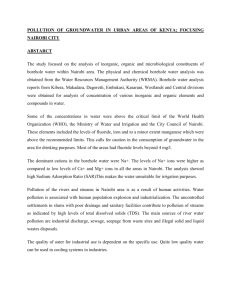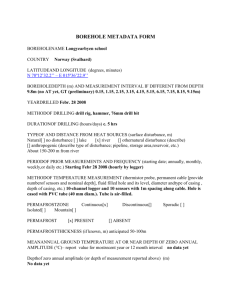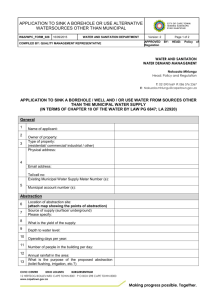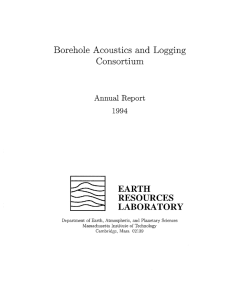REPORT SUMMARY
advertisement
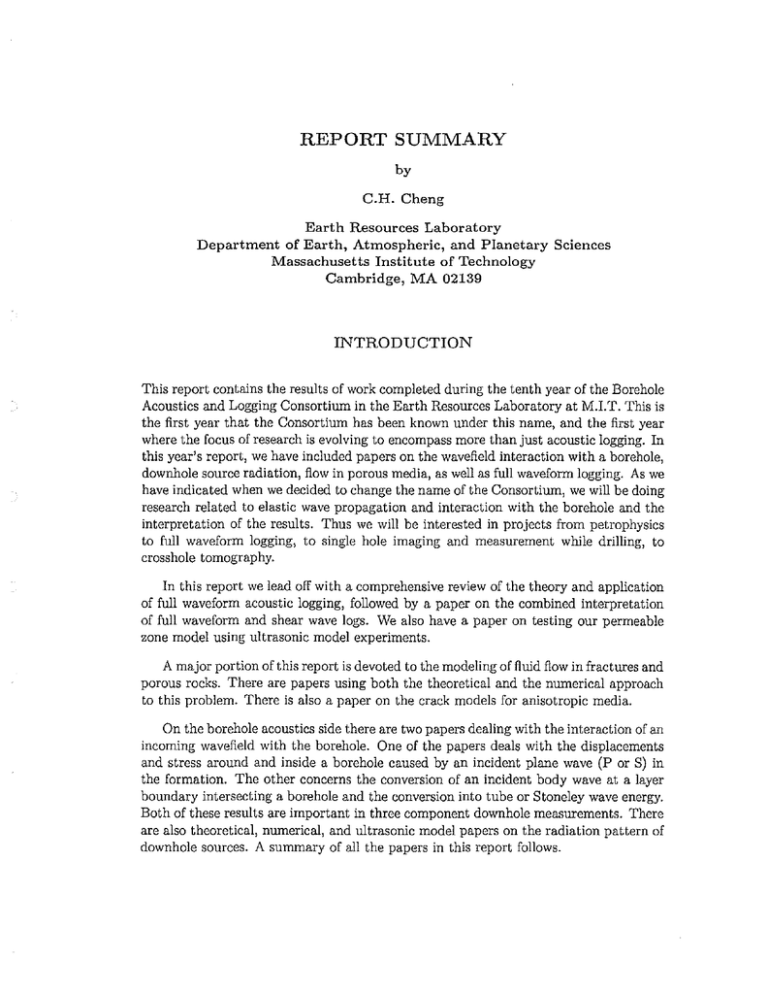
REPORT SUMMARY by C.H. Cheng Earth Resources Laboratory Department of Earth, Atmospheric, and Planetary Sciences Massachusetts Institute of Technology Cambridge, MA 02139 INTRODUCTION This report contains the results of work completed during the tenth year of the Borehole Acoustics and Logging Consortium in the Earth Resources Laboratory at M.l. T. This is the first year that the Consortium has been known under this name, and the first year where the focus of research is evolving to encompass more than just acoustic logging. In this year's report, we have included papers on the wavefield interaction with a borehole, downhole source radiation, fiow in porous media, as well as full waveform logging. As we have indicated when we decided to change the name of the Consortium, we will be doing research related to elastic wave propagation and interaction with the borehole and the interpretation of the results. Thus we will be interested in projects from petrophysics to full waveform logging, to single hole imaging and measurement while drilling, to crosshole tomography. In this report we lead off with a comprehensive review of the theory and application of full waveform acoustic logging, followed by a paper on the combined interpretation of full waveform and shear wave logs. We also have a paper on testing our permeable zone model using ultrasonic model experiments. A major portion of this report is devoted to the modeling of fiuid flow in fractures and porous rocks. There are papers using both the theoretical and the numerical approach to this problem. There is also a paper on the crack models for anisotropic media. On the borehole acoustics side there are two papers dealing with the interaction of an incoming wavefield with the borehole. One of the papers deals with the displacements and stress around and inside a borehole caused by an incident plane wave (P or S) in the formation. The other concerns the conversion of an incident body wave at a layer boundary intersecting a borehole and the conversion into tube or Stoneley wave energy. Both of these results are important in three component downhole measurements. There are also theoretical, numerical, and ultrasonic model papers on the radiation pattern of downhole sources. A summary of all the papers in this report follows. Cheng 2 THEORETICAL DEVELOPMENTS Characterization of Fractures and Permeable Zones In the last years we have presented a simplified theory for Stoneley wave attenuation across and reflection from fractures and permeable zones. We have also presented field data examples to support our theory. Furthermore, we have tested our theory for fractures in the ultrasonic laboratory. In this year's report Zhu et al. (Paper 4) compares the results from ultrasonic models of permeable zones with a slightly revised theory based on the one-dimensional reflection and transmission model for the Stoneley wave presented in Tang and Cheng (1991 Annual Report). The results for three different viscosity borehole and pore fluids agree well with the theory. This gives us a lot of confidence that we are on the right track in this problem of modelling Stoneley wave propagation across permeable zones. Borehole Radiation An important concern in borehole acoustics is the radiation pattern generated by downhole sources. The existence of the borehole not only modifies the radiation patterns of the body waves but also generates "Mach" waves in low shear velocity "soft" formations. Last year Meredith et al. (1991 Annual Report) showed the theoretical basis for this phenomenon. This year Cheng et al. (Paper 10) show finite difference and laboratory models of Mach waves generated from borehole sources. Another factor in borehole radiation is the effect of layer boundaries on the radiation patterns. Bouchon (Paper 12) presents a theoretical formulation based on the boundary integral technique to calculate the radiation pattern of a source in a borehole in a layered medium. This technique has potential applications in single hole imaging, reverse VSP and crosshole tomography. Cheng et al. (Paper 10) show similar results using the finite difference approach. In a paper related more to the VSP geometry, Tang et al. (Paper 11) compared the theoretical and calculated radiation patterns of P- and S-wave transducers in a half space from a finite size source. This is very useful for the correction of amplitudes in ultrasonic model experiments. Borehole Coupling As we go to higher and higher frequencies in single hole imaging and crosshole measurements, the coupling of the wavefield from the formation into the borehole becomes Report Summary 3 an important issue. Peng et al. (Paper 13) present a complete formulation of coupling of the wavefield into the borehole. They found that under most circumstances, the existence of the borehole changes the observed wavefield. This is extremely important in the use of the amplitude information in single hole imaging or crosshole tomography, especially diffraction tomography. Peng and Toksoz (Paper 14) present a theoretical formulation for the coupling of a body wave into tube waves when the former encounters a layer boundary intersecting a borehole. This allows us to have a better understanding of the various mode conversions seen in the field data. DATA ANALYSIS Formation Evaluation In the decade since the full waveform acoustic logging tool became widely available commercially, we have learned a lot about the application of the full waveform data to formation evaluation. In this volume, Paillet et al. (Paper 2) presents a comprehensive review of the theory, data processing, and the application of full waveform logging. In particular, the portion contributed by Wayne Pennington of Marathon gives the perspective of the end user (log analyst) regarding the use of the full waveform data. Since it is a review paper, it contains an extensive reference list of full waveform logging papers available in the literature. In another paper, Cheng and Cheng (Paper 3) use the full waveform acoustic log and the shear wave log together for a combined interpretation. The Stoneley wave, combined with the shear wave velocity from the shear wave log, can be used to estimate formation permeability, as well as formation anisotropy. It is also shown that the shear wave tool, because of possible tool rotation, does not always give the fastest velocity in the vertical direction in the case of azimuthal anisotropy. Thus both full waveform and shear wave logs are necesssary for proper formation evaluation. PETROPHYSICS A significant part of this year's report is devoted to petrophysics. In particular, the issue of flow through a porous medium is addressed from both theoretical and numerical approaches. This has application to the development of a better model of a porous rock and in the modelling of permeable zones. Cheng 4 Flow in Porous Media One of the most interesting and important problems in petrophysics is the flow through rough channels and interfaces. In this report we have three papers addressing this subject from both the theoretical and numerical approach. Pride (Paper 5) addresses the problem of calculatng the drag forces resulting from the fluid flow in a rough channel. Zhao and Toksoz (Paper 6) study the problem of flow in heterogeneous material using a finite difference approach. Zhao et al. (Paper 7) combine the finite difference approach and the dynamic permeability concept we have developed over the past few years to study the problem of flow through rough fractures. All these will allow us to characterize a fracture much better than just the "equivalent" single fracture aperture that is currently used. Crack Models for Anisotropy The widely accepted model for crack induced seismic anistropy has been that of Hudson. However, it is well known that the second order expansion of Hudson is divergent with respect to increasing crack density. Cheng (Paper 9) reformulated the expansion as a Pade series and the result shows a much better behavior. Cheng also compared Hudson's first order expansion with that using the complete theory of Eshelby and found that the Hudson expansion is quite accurate for small aspect ratio cracks. Permeability Anisotropy Zhao and Toksoz (Paper 8) present an update on their work use a finite difference algori thm to model two-dimensional flow through various channels and structures. This technique is very useful in the study of permeability anisotropy caused by aligned cracks and fractures. FUTURE WORK • Borehole Acoustics This is the first year since we have expanded the focus of the Consortium to include borehole acoustic and a renewed interest in petrophysics. In thiS report we present papers on the radiation pattern from a borehole and two on the coupling of the wavefield into the borehole. We will continue to study both the problem of borehole source radiation and the coupling of the wavefield back into the borehole. The ultimate aim is to correct for all the changes in the amplitude of an incoming or outgoing wavefield as a result of the existence of the borehole. Report Summary 5 • Anisotropy: We have interpreted differences in the full waveform and shear wave log as those due to the possible effects of azimuthal anisotropy. Currently we do not have a good theoretical or numerical model for this. In the coming year we will develop a model for both full waveform and shear wave logging in an azimuthally anisotropic formation. The model will consist of a combination of analytical and numerical approaches. • Fracture Characterization: In the past years we have progressed from the cubic law of simple planar fractures to dynamic permeability. This year we have begun to study the effect of rough surfaces. In the coming year we want to pursue this further and see if the roughness of a fracture can be characterized by the frequency dependence of its flow characteristics. • Petrophysics: We have renewed interest in the physics, especially the flow characteristics, of porous rocks. This year we have a paper on the drag forces on the source of a crack as fluid flows across it. We also developed a new crack model for an anisotropic rock. In the coming year we will continue to develop new or improved models for porous rocks. • Data Processing: This year we explore the combined processing of full waveform and shear wave logs. We will work more along these lines in the coming year, especially now that commerical shear wave logs are becoming more available. The emphasis is on areas where the two logs drift apart and we will try to understand the underlying reason behind it such as possible anisotropy. • Ultrasonic Laboratory Models: We have continued to use ultrasonic laboratory models to test and confirm our theoretical predictions. This year we have models of a permeable zone and one to measure the radiation pattern of a downhole source. In the coming year we will have ultrasonic models of the dipole tool. ( (




